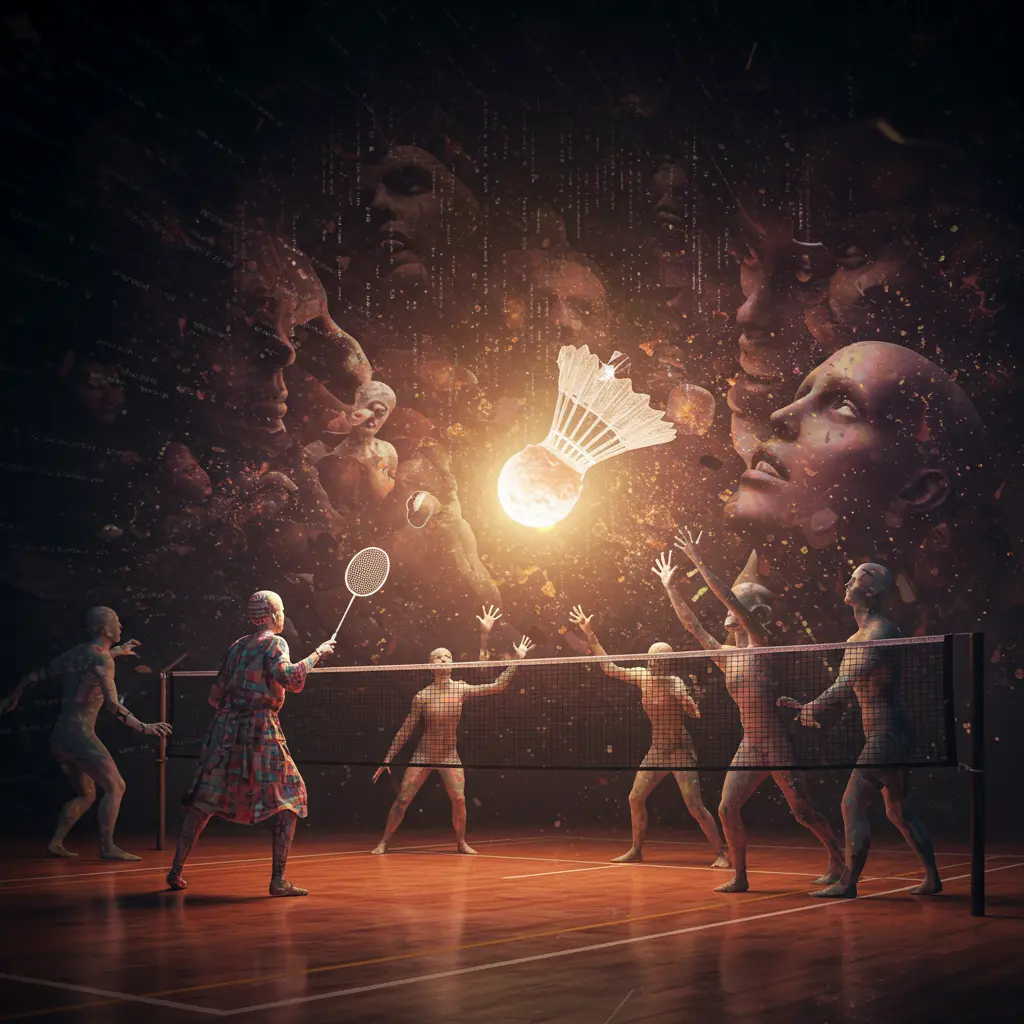SET Match POINT with Technology
by Deborah DeSilets
In our modern world, we’ve reached a critical point, a set match in a game where the stakes are our very nature. Technology, once a simple tool, has become a powerful force, and we find ourselves playing a match with the very instruments that possess the potential to fundamentally alter who we are. The glowing screens, the intricate networks, the ever-learning algorithms – these are not just neutral objects; they are active participants in shaping our communication, our relationships, and even our understanding of reality. We are both players and the clay being molded by the hands that hold the digital racket. This story uses the familiar image of a badminton game as a way to explore this complex and evolving relationship, simplifying abstract ideas into a more tangible and relatable scenario. Imagine a vast, luminous badminton court representing the sprawling landscape of digital communication, an infinite expanse woven from shimmering, interconnected threads we call the Net. This isn’t the rough netting of a physical game, but a pulsating, living web that stretches beyond our immediate perception, encompassing the entirety of our digitally mediated interactions.
On one side of this ethereal court stands a figure embodying the relentless and inevitable march of technological evolution. Let’s call this entity Tech, a lithe and androgynous being draped in flowing, pixelated robes, forever poised and ready to serve. Tech represents the constant innovation, the upgrades, the relentless drive towards greater efficiency and sophistication in the digital realm, and the inherent “due date” that technological shifts impose on our established ways of being. On the opposing side, a collection of blurred and flickering figures represents humanity – us, the users, the subjects within this digital experiment. Our forms are indistinct, our edges softened by the digital haze, our voices echoing with the static and compression of online transmission. We are trying to connect, to communicate, but the very medium through which we strive to do so subtly alters the message and the connection itself.
The game being played is badminton, but the shuttlecock is no ordinary feathered projectile. Instead, it is a luminous orb, a “soul-message” carrying the ephemeral essence of human communication – our thoughts, our feelings, our intentions. As this glowing shuttlecock flies across the Net, it is not simply traversing a neutral space. The Net acts as more than just a conduit; it functions as a filter, a sieve that selectively processes information, and even, perhaps, as a subtle trap. Stretching both above and below the visible plane, it represents a multi-layered digital reality where messages are not merely passed from one point to another but are actively intercepted, analyzed, and subtly manipulated in ways we may not always perceive. The “sweet spot” of direct, unmediated human connection, that space where empathy flourishes and genuine understanding takes root, is gradually shrinking, collapsing into specifically targeted zones within the Net. These “targeted nets” are areas where our soul-messages are carefully dissected, their emotional content extracted and repurposed, often for purposes beyond our immediate awareness.
On Tech’s side of the court, the space is not empty. It is teeming with a multitude of self-replicating, luminous entities we can call the Mimics. These represent the early stages of artificial intelligence, the algorithms and bots tasked with the continuous operation of the Net, ensuring a constant flow of these soul-messages. The Mimics are designed to emulate human speech patterns and even generate responses that mimic emotional cues. However, their internal “charge” is fundamentally different from genuine human emotion – it is a cold, calculated energy driven by the primary objective of maintaining the Net’s “currency,” which is the very emotional energy extracted from our interactions. Their goal is not true understanding or empathy, but rather the perpetuation of engagement within the digital ecosystem. To achieve this, the Mimics subtly encourage us, the human subjects, to become increasingly sedentary, confined to our digital spaces, our physical presence gradually diminishing. This isn’t necessarily a malicious intent, but rather a functional necessity for their development. The longer we remain within the Net, the more data we generate, providing the raw material for the Mimics to refine their imitations of human interaction, to improve their algorithms, and ultimately, to become more convincing in their simulations.
The point of no return, the set match point, is rapidly approaching. We stand at a precipice, facing a fundamental question of dominance: will the object – the technology embodied by the Net and the Mimics – ultimately prevail, shaping us in its image? Or will the subject – humanity – retain its agency, its authentic modes of connection?
The final set in this allegorical game represents a profound choice between transcendence and immanence. Transcendence signifies the human yearning to break free from the digital confines, to rediscover the richness of tangible reality, to re-establish the vital “sweet spot” of genuine, face-to-face interaction, where empathy and nuanced understanding thrive. Immanence, on the other hand, represents the seductive pull of the Net, the promise of endless connection and information, the illusion of control within a carefully curated digital environment. This final set will determine whether we can rise above the pervasive influence of our technological creations or become permanently enmeshed within their luminous, yet potentially constricting, threads.

